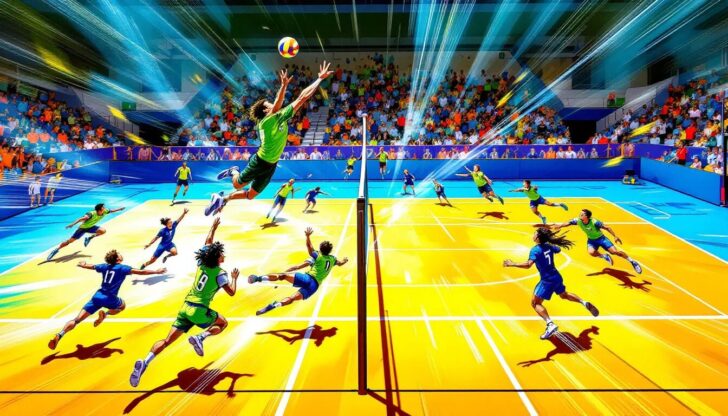Volleyball is a popular team sport played by two teams of six on a rectangular court. The goal is to score points by hitting the ball over the net and grounding it in the opponent’s court. This article will explore the rules, positions, essential skills, and history of volleyball to give you a comprehensive understanding of the game.
Table of Contents
Key Takeaways
Volleyball was invented by William G. Morgan in 1895, combining elements of other sports and evolving into a globally popular game.
The sport has seen significant rule changes, including the introduction of rally scoring and specialized player roles like the libero, enhancing gameplay dynamics.
Volleyball is a prominent Olympic sport since 1964, with both indoor and beach volleyball formats captivating audiences and promoting athlete participation worldwide.
History of Volleyball

Before: William G. Morgan invented volleyball in 1895 at the International YMCA Training School, a place that fostered innovation and physical fitness. Morgan’s vision was to create a new game that combined elements of basketball, baseball, tennis, and handball, resulting in a sport that was both versatile and engaging. The first official volleyball game was played on July 7, 1896, at Springfield College, marking the beginning of what would become a global phenomenon.
After: William G. Morgan invented volleyball in 1895 at the International YMCA Training School, a place that fostered innovation and physical fitness.
Morgan’s vision was to create a new game that combined elements of:
basketball
baseball
tennis
handball
This resulted in a sport that was both versatile and engaging. The first official volleyball game was played on July 7, 1896, at Springfield College, marking the beginning of what would become a global phenomenon.
The name ‘Volleyball’ was suggested by Professor Alfred T. Halstead, who wanted to emphasize the volleying nature of the sport. Morgan designed the game to be adaptable, allowing it to be played both indoors and outdoors, which significantly contributed to its widespread popularity.
From these humble beginnings, volleyball has grown into a sport enjoyed by athletes of all ages and skill levels around the world.
Evolution of Rules
The rules of volleyball have undergone significant changes since its inception. In the 1910s, the introduction of the 3-hit rule revolutionized the game, paving the way for the modern sequence of passing, setting, and spiking. This rule change fundamentally altered how the game was played, making it more dynamic and strategic.
Other notable changes include the reduction of points needed to win a game from 21 to 15 in 1917, and the introduction of the libero position during the 2000 Olympics, which added a new layer of strategy with specialized defensive roles.
The rules governing serves were also updated in 2001 to allow serves that touch the net to remain in play, encouraging more aggressive serving strategies.
Volleyball in the Olympic Games

Volleyball made its official debut at the Olympic Games in 1964 in Tokyo, showcasing the sport on one of the world’s biggest stages. This inclusion marked a significant milestone, elevating volleyball’s status globally and inspiring countless athletes to pursue excellence in the sport. Since then, volleyball has become a staple of the Olympic Games, featuring intense competition and showcasing the highest levels of skill and athleticism.
Beach volleyball was introduced to the Olympic program in 1996, adding another exciting dimension to the games. With both indoor and beach volleyball now prominent Olympic events, the sport continues to captivate audiences and inspire new generations of players.
Court Dimensions and Equipment

Understanding the dimensions of the volleyball court and the equipment used is crucial for both players and spectators. The official volleyball court measures 18 meters long and 9 meters wide, providing ample space for dynamic play. Surrounding the court is a free zone of 5 meters on the sidelines and 6.5 meters at the ends, ensuring player safety and allowing for exciting dives and saves.
The net height is set at 2.43 meters for men’s competitions and 2.24 meters for women’s competitions, creating a challenging barrier for players to overcome. A regulation volleyball has a circumference of 65 to 67 centimeters and weighs between 260 to 280 grams, with an air pressure of 0.30 to 0.325 kg/cm², ensuring optimal performance during play.
Gameplay Mechanics
The primary objective of a volleyball game is to ground the ball on the opponent’s court while preventing the opposing team from doing the same. Each team consists of six players who must work together, utilizing their individual skills to achieve this goal. Teams are allowed up to three contacts with the ball to return it over the net, creating a dynamic and fast-paced game.
A rally concludes when the ball touches the ground, either in the opponent’s court or after a fault is committed by one of the teams. Players have been permitted to legally contact the ball with any part of their body, including their head and feet, since 1996, adding creativity and athleticism to the game.
Scoring System
The scoring system in volleyball has evolved to make the game more exciting and competitive. The shift to rally scoring in 1999 allowed points to be scored by either team on every rally, significantly speeding up the pace of the game. Points are awarded when the opposing team commits a fault or fails to return the ball properly.
Volleyball matches are typically structured as best-of-five sets, with the first team to score 25 points winning a set, provided they achieve a two-point margin. In the decisive fifth set, teams need to score 15 points with a two-point lead to secure the victory.
Player Roles and Specializations
Volleyball teams are composed of volleyball players with specialized roles, each contributing to the team’s overall strategy and success. The main positions include the setter, outside hitter, middle hitter, opposite hitter, and libero. The outside hitter serves as the team’s primary offensive player, responsible for executing attacks and scoring points.
The libero, a specialized defensive specialist player, can only play in the back row and is distinguished by a different colored jersey. Introduced in 1998, the libero position has allowed teams to implement more effective defensive strategies.
Essential Skills in Volleyball
Mastering basic skills is crucial for success in volleyball. Key skills include serving, passing, setting, attacking, blocking, and digging. Each of these skills plays a vital role in the flow of the game and the execution of strategies.
Serving
Serving sets the tone for a volleyball match and can directly lead to points. Elite players often use a jump serve due to its speed and unpredictability, making it challenging for the receiving team to handle. An effective serve involves setting the ball’s direction, speed, and acceleration to create difficulty for the opponents.
Achieving an ace, where the served ball lands in the opponent’s court without being touched, is a testament to the server’s skill and can be a crucial advantage in a tight match.
Passing
Passing is a fundamental skill that sets up offensive plays. The forearm pass, commonly used to receive serves and attacks, provides stability and control, ensuring the ball reaches the setter accurately. A successful pass requires the ball to have relatively little spin, making it easier for the setter to handle.
Setting
The setter plays a pivotal role in orchestrating the team’s offense. The main goal of setting is to position the ball in the air for an attack, requiring precise timing and technique. A setter should touch the ball with both hands simultaneously to maintain control and accuracy.
Attacking
Attacking is crucial for scoring points and applying pressure on the opposing team. Strategies include varying the ball’s placement to confuse the defense, making it harder for them to anticipate and block the attack.
Common attacking techniques include spiking and tipping the ball over blockers, aiming to land it on the opponent’s court.
Blocking
Blocking is a key defensive skill used to stop or alter an opponent’s attack. There are different types of blocks, including single, double, and triple blocks, each involving varying levels of coordination and teamwork.
An offensive block aims to stop an attack and keep the ball in the opponent’s court, preventing them from scoring.
Digging
Digging is essential for preventing the ball from touching one’s court after an opponent’s attack. Effective digging requires players to anticipate the ball’s trajectory and react quickly. Players often use their forearms and body positioning to create angles that facilitate successful digs.
Team Strategies and Formations
Team strategies and formations are crucial for optimizing both offensive and defensive plays for two teams. Common formations include the 4-2, 5-1, and 6-2, each with its strategic advantages and disadvantages.
The 4-2 formation, consisting of four hitters and two setters, provides limited offensive options but can be effective for teams with weaker hitters. The 5-1 formation maximizes scoring potential by having one setter and three attackers in the front row.
The 6-2 formation features two setters and allows all players to act as hitters, enhancing offensive flexibility.
Recent Developments in Volleyball

Volleyball has seen several recent developments aimed at enhancing the pace and excitement of the game. The shift from side-out scoring, where only the serving team could score points, to rally scoring has made matches faster and more engaging for both players and spectators. This change has significantly increased the intensity of every rally, making each point crucial.
Serving rules have also been updated to allow serves that touch the net to remain in play, encouraging more aggressive serving strategies. These innovations have contributed to making volleyball more dynamic and inclusive, attracting a broader audience and encouraging more participation.
Beach Volleyball

Beach volleyball, the most popular variation of the sport, offers a unique twist on traditional indoor volleyball. Played on a sand court measuring 16 meters long and 8 meters wide, it features teams of two players, highlighting the importance of individual skill and teamwork. Matches are typically best-of-three sets, with the first two sets played to 21 points and a potential third set to 15 points.
The differences in playing surface and team size create a distinct playing experience, requiring different strategies and skills compared to indoor volleyball. Beach volleyball’s inclusion in the Olympic Games since 1996 has further popularized this exciting and accessible sport.
Notable Competitions and Organizations
Volleyball’s prominence in the sports world is supported by numerous prestigious competitions and governing bodies. The Fédération Internationale de Volleyball (FIVB) organizes the Men’s and Women’s World Championships, quadrennial events that feature the best teams from around the globe. These championships showcase the highest level of competitive play, drawing significant attention from fans and media alike.
The Volleyball Nations League is another key event, providing an annual platform for national teams to compete and hone their skills. In the United States, USA Volleyball serves as the national governing body, supporting the sport’s development at all levels.
Additionally, Cuba’s women’s teams have been a dominant force in international volleyball by the late 20th century, winning numerous Olympic medals and cementing their legacy in the sport.
Checkout Top 5 Important Tournaments of Volleyball – Forstar Sports
Summary
Volleyball’s rich history, evolving rules, and dynamic gameplay mechanics make it a captivating sport for both players and spectators. Understanding the court dimensions, player roles, and essential skills provides a deeper appreciation of the game’s complexity and beauty. Recent developments and the rise of beach volleyball have further enriched the sport, making it more accessible and engaging for a wider audience.
By exploring the notable competitions and organizations that govern volleyball, one can see the sport’s global impact and the high level of talent it attracts. Whether you are playing, coaching, or watching, volleyball offers endless excitement and opportunities to witness incredible athleticism and teamwork. So, grab a ball, find a court, and experience the thrill of volleyball for yourself.
Frequently Asked Questions
Who invented volleyball and when?
Volleyball was invented by William G. Morgan in 1895 at the International YMCA Training School.
What is the primary objective of a volleyball game?
The primary objective of a volleyball game is to ground the ball on the opponent’s court while simultaneously preventing them from doing the same. This competitive balance defines the essence of the sport.
How has the scoring system in volleyball changed over time?
The scoring system in volleyball changed significantly in 1999 with the introduction of rally scoring, permitting both teams to score points on every rally, which enhanced the speed and competitiveness of the game.
What are the main player roles in volleyball?
The main player roles in volleyball are setter, outside hitter, middle hitter, opposite hitter, and libero, each designated with unique responsibilities essential to team performance. Understanding these roles is crucial for effective gameplay.
How is beach volleyball different from indoor volleyball?
Beach volleyball differs from indoor volleyball primarily in team size, with two players per team on sand versus six players on a hard court. Additionally, the court dimensions and match structure are distinct between the two formats.









